We couldn't wait to start our day by seeing one of the main sights in Gonder, Debre Berhan Selassie or Mountain of the Enlightened Trinity, one of the most beautiful Ethiopian churches. As it was located on the east side of the city, our hotel recommended we walked a couple of blocks to get a tuk tuk for only 2 Birr - a mere nine cents - compared to getting one on the street for 30 Birr or $1.33. That was a no brainer of course! There was an Ethiopian woman in the shared tuk tuk who had studied in Raleigh, North Carolina but had never visited the church despite now attending at the University of Gonder.
Debre Berhan Selassie was consecrated in 1693 with much fanfare when Emperor Iyasu I arrived there on horseback carrying the tabot or Ark of the Covenant on his head! Iyasu appointed more than 150 people to serve in the church, which was regarded as the principal place of worship in Gonder for at least the next century.
Before entering the church, we walked around the church's large grounds. The perimeter wall had 12 equidistant round towers representing the 12 Apostles.
One of the towers was larger than the others as it was possibly intended to house relics associated with the Ark of the Covenant.
The larger 13th tower or entrance gate symbolized Christ and was shaped to resemble the Lion of Judah.
As with other Ethiopian churches we had visited, many people were praying outside.
The original church built for Iyasu I was almost certainly circular and it probably remained the same shape when it was restored after being struck by lightning in 1707. The rectangular stone church now there most likely dates to the late 18th century.




From the moment we had entered the grounds, we could hear over the loudspeakers priests chanting and drums being played. Actually seeing and hearing them sing and play the various instruments in the back of the church was a riveting performance as we hadn't been fortunate to have witnessed that in any of the other churches we had been to in Ethiopia.
These two men alternated playing the drums sitting on the floor with standing up and moving to the music they and the other priests/musicians played in a very choreographed dance. (Those photos are later). We were in the church for well over and hour and I could have stayed put a lot longer listening and watching the 'show.'
Being there at the same time as the priests' chanting was an unexpected bonus as we had come for the stunning art that graced every corner of the ceiling and walls. They were made especially for people at a time who could not read but were taught the religious teachings by viewing pictures. The roof, with its rows and rows of winged cherubs, representing the omnipresence of God, was what first drew our eyes. There was space for 135 cherubs, though 13 have been erased by water damage.


Steven and I were so glad that we had bought a painting of these same cherubs while in Addis Ababa about a week earlier. What a fabulous memento it is of our time at this church.


Every inch of the walls was also covered with religious themes. One of the paintings showed a man in profile, indicating he was a non-believer.

The most common painting in all Ethiopian churches: St. George slaying the dragon.
Through this doorway, we could see a lot of people praying in another part of the church.
I tried to enter the area through an exterior doorway but was told it was reserved for the locals only.

The Last Supper:
One of the most striking individual paintings was an unusually fearsome depiction of the devil surrounded by flames.
The church's paintings were definitely among the most wonderful religious paintings I have ever seen. Those paintings combined with being there at the same time as the priests while they chanted and played their instruments was one of most powerful experiences of our entire trip in my mind.
The photos I mentioned earlier showing the two drummers appearing to dance in time to the music they and others played:
These women often clapped during the musical performance. At other times they read from religious books while standing just outside the doorway to the room where others were sitting or kneeling and praying.
Debre Berhan Selassie is the oldest preserved church in Gonder. When Mohammed the Left Handed ransacked the city, his troops surrounded this church in preparation for its destruction and he destroyed all the other churches in Gonder and other places in Ethiopia. Locals recount how a swarm of bees attacked the intruders and stopped them from destroying the church which was thus saved and remains to this day as a witness to this story. Locals consider this a miracle. It wasn't hard to believe this incident as there are no other churches left in Gonder that predate this amazing church.
There were a number of other sights we wanted to see in Gonder but most were located in different areas well away from the city itself. That meant hiring a tuk tuk to go first from the church on the east side of the city to visit three sights on the west side of town. The driver asked initially for 100 Birr - about $5 - but we ended up settling on one fifth of that. En route to Suviel's Tomb and the other sights in the complex, we passed students all attending the same school, just as we had done when driving in from the airport.
The entrance to the complex that housed Suviel's Tomb, Fasilidadas' Pool and the House of Chickens:
Admission to the three sights was included in our ticket to the Royal Enclosure we had visited yesterday. The 9,100 square foot sunken Fasiladas Pool generally attributed to Emperor Fasiladas was enclosed by a tall stone wall with six turrets. Some sources suggest that the pool was the earliest of Fasiladas' constructions, predating his famous castle in the Fasil Ghebbi that we had toured yesterday. Others attribute the pool to Emperor Iyasu I.
This two-story building is thought to have been Fasiladas' second residence.
Built for ceremonial rather than recreational purposes, the sunken excavation is dry most of the year but is filled with water for Timkat, the Ethiopian Epiphany. Then it forms the centerpiece of a remarkable ceremony where thousands of white-robed worshipers converge around the pool to be blessed and sprinkled with holy water by colorfully attired priests carrying crosses. I can only imagine how beautiful a sight that would be to behold.

The tree roots surrounding the pool and the walls reminded us of those we saw while visiting the amazing temples at Angkor Wat in Cambodia three years ago.
The very precarious seating area overlooking the pool:
The six-pillared domed pavilion that stood outside Fasiladas' Pool is said locally to date to the reign of Emperor Iyasu I, who built it as a mausoleum for his father Yohannes I's favorite horse Suviel. According to this legend, Yohannes I was killed in battle in the Sudan by an unspecified Muslim foe, who then took the injured Suviel captive. Iyasu rescued the horse by dressing as a Muslim, persuading its captives to allow him ride it, then fleeing as quickly as he could.
The Muslims tried to give chase, but fast Suviel lept across a gorge no lesser horse could cross but he and the future emperor returned safely to Gonder. There is no evidence to support this tale; more likely, the little pavilion was where the early emperors of Gonder stood during ceremonies held at the pool. I much preferred the legend!
Close to the pool, a small building known popularly as the House of Chickens is said to have served as a royal chicken run under Fasiladas. More likely though, it was probably a sweating house isolated for the cure of contagious diseases!
Outside the complex, we couldn't help but smile when we saw this man chase this bull around the very busy Revolution Square. The bovine had his own mind where he wanted to go however!
We hired another tuk tuk driver to drive us back to the Piazza in downtown Gonder but then decided to have him drive us instead to both the Ploughshare Women's Training Center and the Woleka Synagogue located several kilometers north of the city.
We were very fortunate to have the Manager of the Training Center show us initially the shop where women with AIDS and single and divorced women living at the center sell their crafts.
The traditional black pottery had a beautiful glaze taught to the women by a Japanese potter who lived at the Center for a couple of years, we were told.
Silk from India was used to eventually weave into clothes.
There was a also a mind-numbing array of gorgeous scarves made by the women.
The women had diversified into basket-weaving.
Cory: This was the scarf I immediately chose for you. I hope you will like wearing it.
The manager then kindly gave us a full tour of the facility.
The Center also had a small farm on site. They grow their own avocados, lettuce, mangoes and have cows in order to produce milk and butter.
We learned most of the women could never read or write before coming to the Center. There, they learned to become 'chemists' by finding out how to dye fabrics and became adept at math by following very intricate scarf designs. The manager told us that money from the US Embassy helps with paying for the women's AIDS medications.
The Center, open for 20 years, was founded by a Briton and is 90% self-supporting from the sale of items made by the women who learn business skills and are shown new markets for their goods and how to market those goods. The manager stated that items fabricated by the women are also consigned to stores in Gonder and Addis Ababa.
One of the Center's new kilns was provided by Japan.
The manager mentioned that 1,243 women have already been trained in a variety of skills and 43 women are permanent workers and teachers. It was very moving seeing first hand how the disadvantaged women were receiving skills that would help benefit them and their families once they left the Center.
Directly across the street from the Center was Woleka, the main residential quarter for centuries of Gonder's Beta Israel who vacated the site between 1895 and 1992 when the Israel government airlifted most of Ethiopia's 'Black Jews' to Jerusalem in order to liberate them from the oppressive regime of Mengistu, the leader of the Communist military junta.
Immediately on stopping by the hut above, we were met by a large group of very pushy (Christian) craft sellers intent on hawking the distinctive clay dolls and other artifacts associated with the departed Beta Israel.
A group of about ten women and girls led us through their village to the synagogue that was a couple of hundred feet in from the road, all the while wanting me to buy, buy, buy items from each one of them.

They were certainly masterful salespeople, I'll give them that! They asked my name, what country I was from, whether I had children, siblings, etc, all to try and establish a personal connection. I have never been subject to such intense pressure to purchase items and that is saying something, considering we have traveled all over the world and been pressured by many other hardcore sellers.

The disused synagogue resembled a typical circular Ethiopian church but with a Star of David on the roof instead of a cross.
As I am sure you could sense, our short time walking through the village and at the Woleka Synagogue was unfortunately neither relaxing or uplifting.
The same tuk tuk driver who had taken us to the Center and then Woleka took us next to Kuskuam, a palatial stone complex constructed as the residence of Empress Mentewab who acted as the regent to Iyasu II after the death of her husband in 1730. It was located at an altitude of about 7,400 feet west of Gonder. The sign we passed said 'We Stand for Better Change.'
The ribbons and flags strung across the road for the last kilometer were for the big celebration held at Kuskuam every year on November 15th, i.e. the previous day. I was disappointed we had missed it but it had occurred in the morning, just as we had arrived at the airport.
The gaily decorated entrance to Kuskuam:
The church of Kuskuam Maryam, set in the complex with the royal residence, suffered the same fate as most Gonderine churches during the Mahdist War of 1887. It was rebuilt during the Italian occupation of Ethiopia.
The decorations were in honor of the celebrations held the previous day.
It was unusual seeing any flowers or plants anywhere in Ethiopia; thus the reason for this photo taken in the grounds near the church.
A priest opened up the church for us after we paid the admission fee.
Scenes from the church:
None of the church paintings dated to before 1970.
This religious text was in the ancient Ethiopian language, Ge'ez, which originated in Eritrea and the northern region of Ethiopia. It later became the official language of the Ethiopian imperial court.
The bones of Mentewab and Iyasu II were housed in this glass coffin - probably more than we needed to have been shown!
From the church, we walked around the massive palace grounds which were in a state of almost total ruin. Unfortunately with no guide, we knew little about what we were seeing.
We had seen this same guide and German tourist earlier at both the incredible Debre Berhan Selassie Church and also at Fasiladas Pool. Too bad we hadn't asked if we could also join his tour!
There was plenty of bird life in the juniper and olive trees surrounding the church and palace, including these huge vultures!
An ornate Gonder cross was carved over one archway.
I overheard the guide say that this area was where the religious scholars practiced.
This palace building was used for special occasions.
The towers were built directly into the walls that surrounded the palace.
I think with 20/20 hindsight, we definitely should have arranged for a guide to show us around Kuskuam as I feel we missed so much.
On the way back to Gonder, our tuk tuk driver pointed out these homes where the Kuskuam Maryam church students lived.

In the Piazza in the center of Gonder was the statue of Tewodros, the Emperor of Ethiopia from 1855 until his death in 1868. It was put up by the Gonder City Administration in 2012.
Across from the statue was the city's biggest building, the post office. We checked into mailing home a 16 pound package of souvenirs but discovered the only option was by air for $120. Needless to say, we decided that we would just carry them with us for the next month at that rate!
It had been three long months since I had my hair cut by Linda, who has been cutting my hair for years back home and I desperately needed to have it cut. I had hoped to get it cut in Addis Ababa or in Lalibela but this was literally the first place I had time to have it done.
Since it was only about 3 p.m., we figured that this was also the only day in the foreseeable future I could finally get it done. I was a tad leery at the prospect of getting it cut in a 'salon' in Gonder but figured it would grow out quickly enough if I got a really bad cut!
The woman spoke some English but had never cut a Western woman's hair before. She had no clue how to layer it so Steven attempted to show her!
Oops - this is where she took way too much off!
Steven said he could have given me a better haircut but I figured that this was all part of the adventure of traveling to some very out of the way places! I was generally quite pleased with the cut except for the chunk cut out on the right side. Oh well, I couldn't complain as it only cost $2.50 with tip! I just hoped that I looked presentable enough for our son's graduation in exactly one month's time, i.e. the day after returning home!
The Salon in Gonder:
Bet you'd never think this was a hamburger that I ordered that night at dinner in the hotel restaurant? I had doubts too after eating a bite; at least the fries were decent!
What a full day we had had starting out with the amazing paintings and chanting priests at the Debre Berhan Selassie Church followed by our visit to Fasiladas' Pool, Suviel Tomb, the tour of the Women's Training Center, the pushy women at the Woleka Synagogue, the drive out to see the church and palace ruins of Kuskuam and finally The Haircut to top it all off! Tomorrow would be an altogether different type of day as we'd be going on a day trip to the Simien Mountains.
Posted on December 26th, 2016 from Littleton, Colorado.













































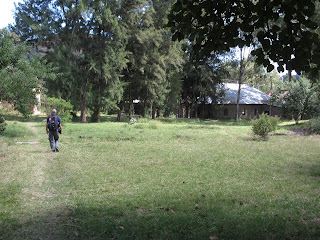













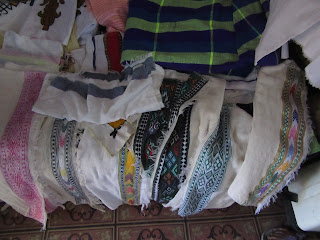






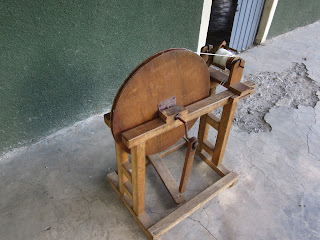
































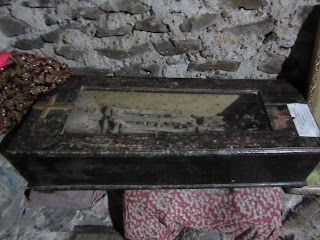














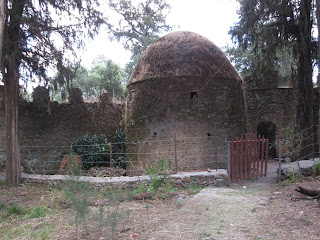












I'd be afraid of that devil, too. Lil Red
ReplyDelete